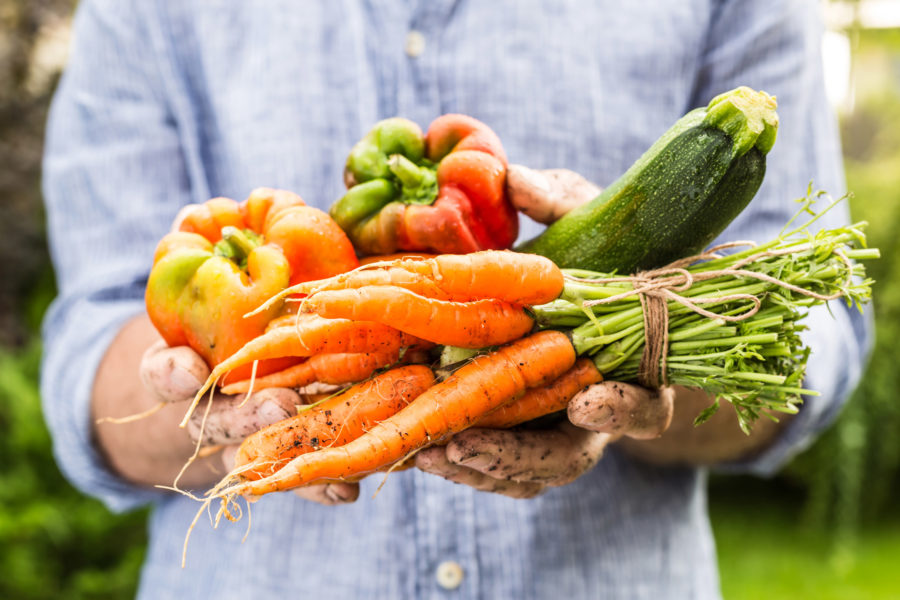Yay: It’s CSA (community sustained agriculture) season!
We bet you can’t wait for your fridge to be bursting with budget- and planet-friendly — no middleman, no fossil-fuel transport, maybe even organic — local veggies and fruits for the next 20 weeks (the typical CSA span).
That’s a lot of produce. Although most farms give CSA shareholders advance notice on what will be ready to harvest when, the quantity you get in real life might be a big surprise. Early in the summer, it could be four heads of highly perishable greens. Later on, it might be 10 pounds of tomatoes.
Week after week, it’s all on you to figure out how to eat it while it’s fresh, and keep that beautiful bounty from ending up in the compost bin or garbage.
Here’s our primer on how to do it:
STEP 1: To Wash, or Not, and Store It ALL
Some people prefer to wash everything up front. But, it’s okay to store what you get au naturale, dirt and all.
Either way, you should handle everything to identify what needs to be used first, remove any insects hiding among leafy greens, and store everything based on its freshness requirements. For instance: To keep root vegetables crisp, remove their green tops (carrot, radish, beet, turnip and celery root tops are edible) before refrigerating them.
Vegetables: Make sure to dry any washed vegetables completely (a little dampness on leafy ones is okay), and store them in air-tight plastic or glass containers. Exceptions: Leave asparagus tips uncovered, peaking out of their plastic bag to breathe. Cucumbers and peppers also like some air circulation, or they’ll rot, so put them directly into your crisper drawer. Store only overripe tomatoes in the fridge, others just on the counter.
Fruits: Most fruits prefer to be rinsed just before use, especially berries. Berries (and a lot of other summer fruit) taste best if left at room temperature and consumed within a day or so after they become fully ripe (for stone fruits). Cover berries and ripe summer fruit loosely before refrigerating for a longer shelf life — remember, many of the varieties you’ll receive from a local farm are more perishable than those grown for commercial shipping.
STEP 2: Plan Use According to Shelf Life
Tender salad greens, cucumbers, peppers, snow peas and broccoli, should make raw appearances sooner rather than later. Spinach, arugula and tougher greens can be frozen raw (chop first to condense space) to use in soups or other cooked dishes. Briefly blanch and freeze snow peas, broccoli, cauliflower, summer squash or zucchini.
Keep a covered assortment of chopped fresh veggies and hummus on a platter in the fridge all summer long. Grill sliced veggies like eggplant, summer squash, zucchini and sweet peppers to extend their life by tossing them with a flavor-forward vinaigrette and some snipped fresh herbs.
Vinegar and salt can be used to preserve lots of veggies, raw or briefly blanched. Cukes become super-easy fridge pickles. Salt and lime juice does something similar to tomatoes in pico de gallo.
Treat herbs like cut flowers: snip ends and place in water. Extend their life as an oil-based pesto. Or mince and freeze them in ice cube trays.
Use fresh fruit in compotes and baked goods. Chop and freeze fresh fruits on a cookie sheet, and then transfer to freezer bags for future baking or smoothies.
STEP 3: Can It
The basics of canning aren’t that hard to master, and Mason jars and supplies are readily available at most supermarkets. If you want to try preserving some of your CSA haul — think holiday gifts like pickled veg or jams — ask your CSA when you’ll receive enough of the main ingredient you plan to “put up,” as Great-grandma might have said.



 3 min read
3 min read


